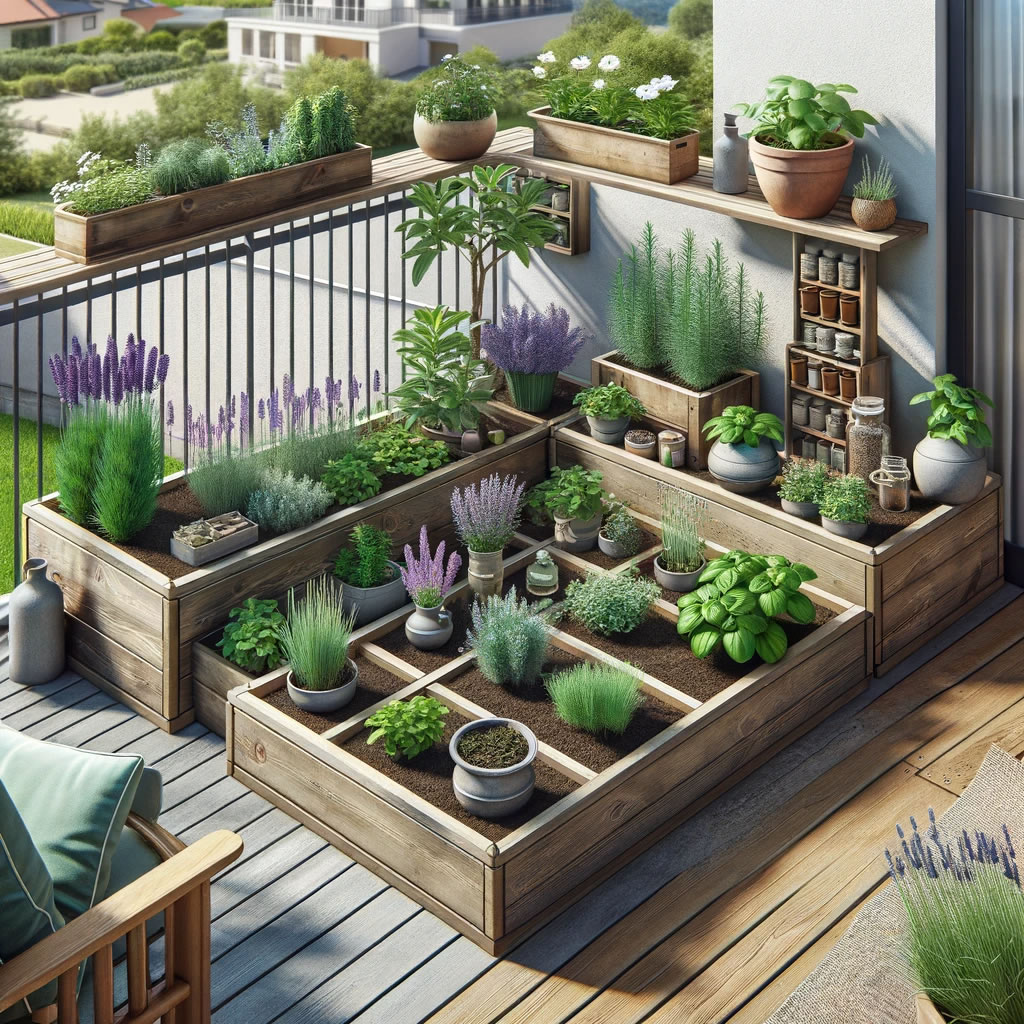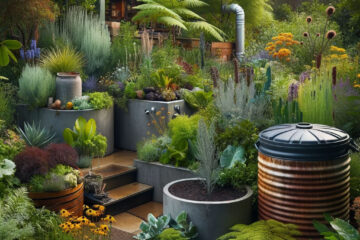Growing medicinal plants at home offers a convenient and empowering way to enhance your wellness routine.
By cultivating a medicinal herb garden, you are taking a step towards self-sufficiency and gaining a deeper appreciation for the healing power of plants.
These herbs can serve a variety of purposes, from improving digestion to soothing skin irritations, and they can be easily integrated into your daily life.
Starting your own home garden with medicinal plants is simpler than you might think, and it doesn’t require much space.
Many herbs can thrive on a sunny windowsill or in small containers on a balcony. With a bit of care, these plants can flourish, giving you a fresh supply of natural remedies right at your fingertips.
Whether you’re an experienced gardener or new to the world of horticulture, there’s a wealth of plants suitable for every skill level.
Incorporating herbs from your garden into your health regimen can be as simple as brewing a cup of tea with fresh leaves or creating your own topical applications.
Medicinal herbs like chamomile, lavender, and peppermint are not only therapeutic but can also add beauty and fragrance to your home.
Growing these plants can provide a sense of accomplishment and well-being, as you nurture them from seed to remedy.

Table of Contents
Creating Your Medicinal Herb Garden
Creating your own medicinal herb garden requires careful planning and preparation.
Here, you’ll learn the essentials: choosing the ideal location, selecting the right herbs for your needs, and understanding the soil and planting techniques that will ensure your garden thrives.
Choosing the Right Location and Conditions
Your garden’s location is pivotal for optimal growth. Most medicinal plants, such as chamomile, lavender, and peppermint, require at least six hours of direct sunlight per day.
When selecting a spot, whether indoor or outdoor, ensure that the area receives sufficient light.
If you’re limited on space or lack ideal ground conditions, consider containers as they offer the flexibility to move plants to better-lit areas and fit into any garden design.
Outdoor Considerations:
- Space: Evaluate the physical space of your garden, allowing each plant room to grow without competition for sunlight or soil nutrients.
- Growing Conditions: Assess your local climate’s influence on your garden, since some herbs, like ginger and turmeric, prefer warmer temperatures.
Indoor Alternatives:
- Light: South-facing windows often provide ample light, but you can supplement with grow lights if natural light is insufficient.
- Containers: Ensure they have adequate drainage and are large enough to accommodate the root growth of plants like aloe vera and rosemary.
Selecting Medicinal Plants and Herbs
Begin by choosing herbs that suit your climate and health needs. Some popular choices include:
- Feverfew and echinacea, known for their immune-boosting properties.
- Lemon balm and valerian, which may help in anxiety and sleep disorders.
- Rosemary and thyme, for their antimicrobial benefits.
Consider start with a few versatile herbs like basil, oregano, and lavender that adapt well to various conditions and provide a range of uses.
Soil Preparation and Planting Techniques
A healthy garden starts with the soil. Prepare your garden bed by ensuring that the soil type is suitable for the herbs you wish to grow. It should drain well yet retain enough moisture.
Fortify your soil with organic matter or a well-balanced fertilizer to provide the necessary nutrients.
Soil Preparation Steps:
- Remove weeds and debris.
- Add compost or organic matter.
- Test and adjust pH levels according to the herbs you plan to grow; most prefer a pH between 6 and 7.
Planting Techniques Growing Medicinal Plants at Home:
- Cultivation: Gently tamp the soil around the seeds or seedlings to ensure contact without compacting the soil.
- Watering: Water adequately post-planting; herbs like rue and lavender require less water, reflecting their Mediterranean origins.
By carefully considering these aspects, you set the stage for a thriving medicinal herb garden.
Care and Maintenance for Healthy Growth
Ensuring your medicinal plants thrive involves specific practices that cater to the unique needs of each species.
Precise watering, feeding, and pruning are paramount in cultivating plants that can yield the full spectrum of their healing properties.
Watering and Feeding
Your medicinal plants require consistent watering to establish deep and robust root systems.
Use a soil moisture meter as a guide; many healing herbs prefer soil that’s moist but not waterlogged. Fertilizing should be done with care, favoring organic options like compost or fish emulsion, which can provide a wide range of nutrients.
Frequency of fertilization varies, but it is often recommended to apply a balanced, water-soluble fertilizer every 2-4 weeks during the growing season.
- Light: Adequate light is crucial. Place your plants where they can receive the optimal light for their specific needs, which can range from full sun to partial shade.
- Soil: Aim for well-draining soil rich in organic matter to ensure healthy growth and prevent root rot.
Pruning and Managing Plant Growth
Pruning is beneficial for managing the size and shape of your plants, as well as promoting new growth.
Most annual and perennial herbs can be pruned regularly. Doing so can stimulate the plant to produce more foliage, which is often the part used in remedies.
- Pruning: Snip off any dead or dying foliage to maintain plant health and aesthetics.
- Height: Monitor your plant’s height and spread, maintaining them through pruning to support air circulation and reduce the risk of disease.
Remember, consistent care tailored to each plant’s needs is key in home cultivation.
Harvesting and Utilizing Your Medicinal Herbs
In creating your healing garden, understanding the correct techniques for harvesting and transforming your plants into effective home remedies is crucial for maximizing their medicinal potential. Here’s how to proceed from plant to remedy.
Best Practices for Harvesting Herbs
To ensure potency and sustainability, always harvest herbs in the morning after the dew has evaporated but before the heat of the day.
Use sharp, clean shears to cut, and never harvest more than a third of the plant, allowing it to continue thriving.
Harvest flowers and berries when they are fully developed and pick leaves or stems before the plant flowers for maximum efficacy.
Processing Herbs for Medicinal Use
Once harvested, herbs can be dried, frozen, or used fresh. Dried herbs are best stored in airtight containers away from direct sunlight to preserve their strength.
Fresh herbs like lavandula (lavender) can make a fragrant herbal tea or be processed into a tincture or syrup.
These preparations concentrate the beneficial compounds and can be used to address health issues such as anxiety, indigestion, or insomnia.
Creating Remedies and Treatments at Home
Convert your harvested herbs into natural remedies using simple techniques:
- Anti-inflammatory agents, like turmeric, can be infused into oils or creams for pain relief.
- For immune system support or to combat infections, echinacea or garlic can be made into tinctures.
- Herbal teas are a gentle option for liver health or managing arthritis.
Be sure to consult a physician before treating health issues or integrating home remedies into your regimen, especially for serious conditions like cancer.
By learning from traditional medicine and staying informed through channels like a newsletter, you can responsibly use your garden’s bounty.
Frequently Asked Questions
Growing Medicinal Plants at Home can offer both therapeutic benefits and the satisfaction of gardening.
These FAQs are designed to help you get started and navigate some common considerations in the cultivation of medicinal herbs.
What are some of the most beneficial medicinal plants to grow in a home garden?
Medicinal plants such as goldenseal and feverfew have been cherished for their healing properties. Goldenseal is known for its antimicrobial benefits, while feverfew is traditionally used to prevent migraines.
How does one start a medicinal herb garden for beginners?
Beginner gardeners should select easy-to-grow herbs like yarrow and mint. Starting with herbs that have a variety of uses and can thrive in your local climate aids in an enjoyable and sustainable gardening experience.
Which medicinal herbs are suitable for indoor growing conditions?
Herbs like lemon balm and peppermint are suitable for growing indoors as they can thrive in pots and require moderate light. Herbs that favor warmer conditions can be started on a sunny windowsill.
Can medicinal plants be effectively grown in pots, and if so, which varieties?
Yes, many medicinal plants can be grown in pots, such as rosemary and basil. These herbs adapt well to container living, making them perfect for those with limited garden space.
What is the most efficient layout for a medicinal herb garden?
Creating a layout that allows easy access to all plants while maximizing sunlight exposure is ideal. Raised beds or designated sections for each type of herb can facilitate efficient growing and harvesting.
Is cultivating medicinal herbs at home economically viable and potentially profitable?
Growing your own medicinal plants can save money on herbal remedies and has the potential for profit if you scale up production. Herbs like echinacea and lavender are in demand and can be sold fresh, dried, or processed into value-added products.




[…] important to choose plants that are well-suited to your specific growing conditions to ensure they thrive in your flower […]